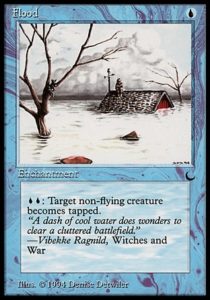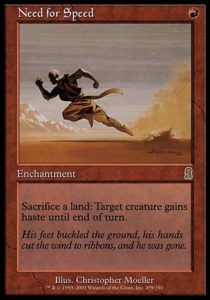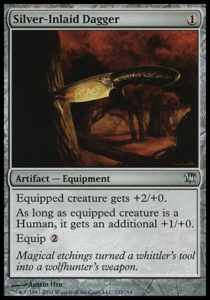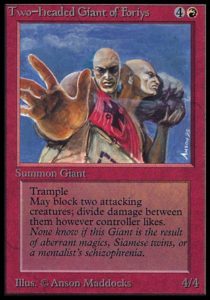Kaladesh prerelease is over! Now, we’ve got a sweet new Limited format. It’s simpler than what we’ve seen for the last few years, but has plenty of sweet options in its three flexible mechanics and lenticular cards. It’s a brighter, more optimistic world than Magic generally features. In other words, it’s really different, and that’s great!
It’s also one of the only Limited formats in recent memory where folks have made some reasonable arguments for running only sixteen lands in Sealed. That’s been a pretty blasphemous statement these past few years, but there’s a decent reason for that: Magic is and has been full of mana sinks. That is, until Kaladesh came around and bucked this trend.
Mana Sinks v. Mana Flood
Mana sinks are wonderful! They give you stuff to do with your mana at all stages of the game. You’re usually doing well when you’re using all of your mana, and that’s generally easy to do in the early game. However, once you start hitting the top of your curve, land drops aren’t as helpful and mana starts going unused. That’s where mana sinks come into play.
Perhaps the quintessential mana sink mechanic is kicker—early on in the game (when you have access to less mana), you get a reasonable spell (like Jilt). Later on, you have extra mana to kick the spell and get a more powerful effect.
Many mechanics in Magic are mana sinks: Sometimes extra mana empowers them or grants an additional effect (as in Entwine and Flashback), sometimes extra mana allows you to circumvent a cost (as with Emerge and Delve). Looking at Magic’s recent history, almost every (non core) set has had at least one named mechanic which is a mana sink:
- Shadows Over Innistrad: Investigate, Emerge
- Battle for Zendikar: Awaken, Landfall*
- Khans of Tarkir: Morph, Megamorph, Outlast, Delve
- Theros: Monstrosity, Bestow
- Return to Ravnica: Overload, Scavenge, Extort, Fuse
- Innistrad: Flashback
*Landfall is kind of a mana sink. It doesn’t give you anything to do with excess mana, but it does give you value for late land drops. Also, the Eldrazi, while not a mechanic per se, were excellent and abundant mana sinks.
The last major set lacking a mana sink mechanic was Avacyn Restored, back in 2012. The format had plenty of flaws (it’s considered among the worst Limited formats in recent history), but part of what tipped the balance is that none of the set’s mechanics allowed flexible use of mana at different times. In AVR, everyone always raced each other because there was nothing else to do.
Less Sinks = More Speed
Kaladesh is unlike almost all recent sets in that it has no mana sink mechanics. Vehicles are undercosted creatures which need to be crewed. Energy is a separate resource with its own economy. Fabricate has no effect after its trigger resolves. None provide a use for excess mana.
Now, a lack of mana sink mechanics isn’t damning (Magic Origins was a perfectly fine Limited format), but it should increase the speed of the format. If there’s less for players to do when they have a lot of mana, then land drops past the fourth or fifth have dramatically diminishing returns. Mana flood becomes far more punishing when there are few sinks. Therefore, players are rewarded for drawing fewer lands, looting them away, or even putting fewer in their decks. Hence, folks have been advocating for fewer lands.
Other Sinks Can Help . . . Sometimes
Sometimes, individual cards or evergreen mechanics can create mana sinks. Equipment and card draw are classic examples: a piece of equipment generates ample opportunities to use one’s mana (whenever you’ve got leftover mana, you can move the equipment to the best possible creature, or switch it between your best attacker and best blocker). Similarly, card draw allows you to have a full hand later in the game, so you’ll benefit from a surplus of mana more than your opponent will.
Kaladesh’s equipment and card draw are weak and low in number. Inventor’s Goggles and Torch Gauntlet are it, and neither is stellar (though perhaps they’re appreciably better than they’d be in another set, since there are fewer mana sinks competing with them). As for card draw, blue has Glimmer of Genius, Nimble Innovator, and Tezzeret’s Ambition, while black has Live Fast. There’s also Key to the City, the delightfully awkward card which requires you to play the lands you want to loot away in order to have mana left over to actually cast spells. Blue is the only color which really benefits from the game going long (which is about par for the course for blue).
Looking elsewhere, Kaladesh has a variety of artifacts which provide value over time. Looking at commons and uncommons (since rares aren’t at all reliably opened in Limited), the Puzzleknots, Decoction Module, Fabrication Module, and Whirlermaker all have repeatable effects for a hefty mana cost . . . and all of them are pretty weak. Perhaps they’re better than they look (since there are slim pickings for mana sinks), or perhaps they’re too situational and most players would benefit from fewer lands or shorter games. 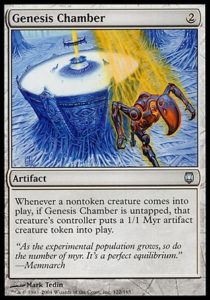
Sinking Ahead
Kaladesh is still an extremely young format (it’s not even out yet!), and predicting it will be faster than recent sets or want fewer lands are bold predictions with no guarantee of proving true. In fact, faster formats often require higher land counts, since being able to play on curve (with the top twelve cards of your library) is more important than having action past turn six.
Only time will tell whether Kaladesh is as fast as a Fleetwheel Cruiser, or more of a Bomat Bazaar Barge.
And Now, Two-Headed Giant
Before we part ways for a week, I’d like to talk for a brief moment about 2HG. It’s a fun, casual format usually reserved just for prereleases. I don’t play it much anymore, but this weekend, I sleeved up alongside my partner (in all senses of the word) for her first ever 2HG experience. She’s a solid player (and waaaaay Spikier than I), and getting to play with her, watch her learn the interactions, and improve before my eyes warmed my heart.
She piloted an overtly powerful BG deck chock-full of fabricate creatures, having Marionette Master and Cultivator of Blades as finishers. I supported her with a UR deck of decent removal, dorky creatures (which produced energy), and a Torrential Gearhulk. Our decks worked nicely in concert: she was the forceful Paladin, creating a shield of creatures, while I was the roguish mage, bolting our foes and clearing a path for her (this was also a nice change of pace, since our decks embodied each other’s preferred D&D classes, but I digress). We went 3-0 in games that varied from dominating victories to come-from-behind triumphs.
So, what’s the point? I had a great time with my partner, and so should you. The point of Two-Headed Giant is to have fun, so I recommend you encourage your best friend, your significant other, or even someone you don’t know well but would like to get to know better to join you as two heads in one. It’s a wonderful bonding experience, even if you’re not at the same experience or skill level. Just take it slowly, let your partner decide for themselves what to do (with as much help from you as they want), and have a blast. You’ll both have a great time even if you don’t win anything (that is, if they’re even marginally less Spikey than my partner—she demands total victory). ’cause in the end, while we all have our own reasons to play Magic, we’re all in this to have fun.
As always, thanks for reading.
—Zachary Barash
Zachary Barash is a New York City-based game designer. He’s played Magic since 1994, he loves Limited and drafts every available format (including several that aren’t entirely meant to be drafted). He quite enjoys Revolutionary Rebuff, since that card demonstrates just how insanely good Mana Leak and Miscalculate are.

